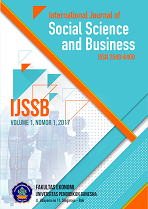Who Intends to Enter the Formal Sector the Most? Individual-Level Determinants of Formal Job Selection in Indonesia
DOI:
https://doi.org/10.23887/ijssb.v8i3.81023Keywords:
Formal sector, Informal sector, LaborAbstract
The informal sector in the labor market is often regarded as filled with low-quality, low-productivity, low-wage jobs. However, in Indonesia, the informal sector is important in absorbing more than half of the total workforce and providing subsistence wages for those not absorbed in the formal labor market. This study used SUSENAS microdata to determine the workforce determinants in working in the formal and informal sectors. The study results show that higher education, male gender, and living in an urban area increased one's chances of working in the formal sector. This study also found an inverted u-shaped curve on age, where a person's tendency to work in the formal sector would increase at the beginning of their productive age and decrease after entering the age of 27. Marital status in this study increased opportunities to work in the informal sector. This research may use to improve the labor policy and improve the job opportunity in both formal and informal sector.References
Ahmad, Nobil A. (2008). Dead men working: time and space in London's (illegal) migrant economy. Work, Employment and Society, 22(2), 301-318.
Amini, A. F., Sugiharti, L., Aditina, N., & Meidika, Y. A. (2020). Analisis migran risen di sektor formal dan informal: Hasil Sakernas 2018. Jurnal Ekonomi Dan Bisnis, 23(1), 37-52.
Anand, R., Kothari, S., & Kumar, N. (2016). South Africa: Labor market dynamics and inequality. International Monetary Fund.
Assaad, R., Krafft, C., & Selwaness, I. (2017). The impact of early marriage on women's employment in the Middle East and North Africa (No. 66). GLO Discussion Paper.
Assaad, R., Krafft, C., & Selwaness, I. (2022). The Impact of Marriage on Women's Employment in the Middle East and North Africa. Feminist Economics, 28(2), 247-279.
Bromley, R. (1979). Urban Informal Sector. London: Pergamon.
Brown, A. M. B., & Roever, S. (2017). Enhancing productivity in the urban informal economy. DFID-ESRC Joint Fund for Poverty Alleviation Research, RES-167-25-059 Making Space for the Poor: Law, Rights, Regulation and Street-Trade in the 21st Century.
Charmes, J. (2012). The informal economy worldwide: Trends and characteristics. Margin: the journal of applied economic research, 6(2), 103-132.
Chen, M.A. (2001). Women and informality: A global picture, the global movement. SAIS Review 21 (1): 71–82.
Cichello, P., & Rogan, M. (2017). Informal sector employment and poverty in South Africa: identifying the contribution of 'informal' sources of income on aggregate poverty measures. Southern Africa Labour and Development Research Unit (SALDRU), University of Cape Town, Cape Town, South Africa.
Dewi, S., Listyowati, D., & Napitupulu, B. E. (2020). Sektor informal dan kemajuan teknologi informasi di Indonesia. Jurnal Mitra Manajemen, 11(1).
Doğrul, H. G. (2012). Determinants of formal and informal sector employment in the urban areas of Turkey. International Journal of Social Sciences and Humanity Studies, 4(2), 217-231.
Elizabeth, R. (2007). Revitalisasi ketenagakerjaan dan kesempatan kerja terkait strategi dan kebijakan pembangunan pertanian dan pedesaan. None, 7(3), 44057.
García, G. A., & Badillo, E. R. (2018). Rationing of formal sector jobs and informality: The Colombian case. Journal of International Development, 30(5), 760-789.
Gennari, P. (2004). The estimation of employment and value added of informal sector in Pakistan. Paper presented at 7th Meeting of the expert group on informal sector statistics, February, 2–4. New Delhi: Delhi Group.
Guha-Khasnobis, B., & Kanbur, R. (Eds.). (2006). Linking the formal and informal economy: concepts and policies. OUP Oxford.
Gundogan, N., & Bicerli, M. K. (2009). Urbanization and labor market informality in developing countries.
Gutierrez, I. A., Kumar, K. B., Mahmud, M., Munshi, F., & Nataraj, S. (2019). Transitions between informal and formal employment: results from a worker survey in Bangladesh. IZA Journal of Development and Migration, 9(1), 1-27.
Hakim, L. (2012). Perkembangan tenaga kerja wanita di sektor informal: Hasil analisa dan proxy data sensus penduduk. Among Makarti, 4(1).
Harris, J.R. and Todaro, M.P. (1970). Migration and Unemployment: a Two-Sector Analysis. American Economic Review 60, 126–142.
ILO. (2013). The Informal Economy and Decent Work: A Policy Resource Guide. Geneva: ILO.
ILO. (2018). Women and men in the informal economy: a statistical picture (third edition) / International Labour Office – Geneva: ILO.
Jati, J. H., Giyarsih, S. R., & Muta'ali, L. (2021). The Influence of Characteristics of Worker and Business on the Income of Informal Sector Workers in Yogyakarta. Populasi, 29(1), 77-92.
Lutz, W., & Samir, Kc. (2011). Global human capital: Integrating education and population. Science, 333(6042), 587-592.
Mabilo, M. (2018). Women in the informal economy: Precarious labour in South Africa (Doctoral dissertation, Stellenbosch: Stellenbosch University).
Mankiw, N. G. (2014). Principles of economics. Cengage Learning.
Manning, C., & Pratomo, D. S. (2013). Do migrants get stuck in the informal sector? Findings from a household survey in four Indonesian cities. Bulletin of Indonesian Economic Studies, 49(2), 167-192.
McCaig, B., & Pavcnik, N. (2015). Informal employment in a growing and globalizing low-income country. American Economic Review, 105(5), 545-550.
Pakistan Federal Board of Revenue. (2008). Informal economy in Pakistan. Directorate General of Training and Research, Syndicate Report 36th STP.
Permatasari, A. D. (2018). Determinan Pekerja Anak di Provinsi Jawa Barat (Doctoral dissertation, Universitas Airlangga).
Pitoyo, A. J. (2007). Dinamika Sektor Informal Dl Indonesia Prospek, Perkembangan, dan Kedudukannya dalam Sistem Ekonomi Makro. Populasi, 18(2).
Richardson, H. W. (1984). The role of the urban informal sector: An Overview. Regional Development Dialogue, 5(2), 3-40.
Rodin, D. L., McNeill, K., Vite-Leon, N., & Heymann, J. (2012). Determinants of informal employment among working mothers in Mexico. Community, Work & Family, 15(1), 85-99.
Sankaran, Kamala. (2022). Transition from the Informal to the Formal Economy: The Need for a Multi‐faceted Approach. The Indian Journal of Labour Economics (2022) 65:625–642.
Sari, N. P. (2016). Transformasi pekerja informal ke arah formal: Analisis deskriptif dan regresi logistik. Jurnal Ekonomi Kuantitatif Terapan Vol.9 No.1, pp 28-36.
Setyanti, A. M. (2020). Informality and the education factor in Indonesian labor. Journal of Indonesian Applied Economics, 8(2), 71-80.
Sheikh, R. A., & Gaurav, S. (2020). Informal work in India: A tale of two definitions. The European Journal of Development Research, 32, 1105-1127.
Sugiharti, L., Aditina, N., & Esquivias, M.A. (2022). Worker Transition Across Formal And Informal Sectors: A Panel Data Analysis In Indonesia. Asian Economic and Financial Review, 2022, 12(11): 923-937.
Survei Angkatan Kerja Nasional (Sakernas) 2022. (2022). Jakarta: Badan Pusat Statistik.
Uribe J, Ortiz C, García G. 2007. La Segmentación del Mercado Laboral Colombiano en la Década de los Noventa. Revista de Economía Institucional 9(16): 189–221. e, timber and mining (pp. 1-28). IIED Working Paper.
van Ham, M., Mulder, C. H., & Hooimeijer, P. (2001). Spatial flexibility in job mobility: macrolevel opportunities and microlevel restrictions. Environment and Planning a, 33(5), 921-940.
Verick, S. (2010). Unraveling the impact of the global financial crisis on the South African labour market. International Labour Organization.
Wang, J., Cooke, F. L., & Lin, Z. (2016). Informal employment in China: recent development and human resource implications. Asia Pacific Journal of Human Resources, 54(3), 292-311.
Williams, C. C., Shahid, M. S., & Martínez, A. (2016). Determinants of the level of informality of informal micro-enterprises: Some evidence from the city of Lahore, Pakistan. World Development, 84, 312-325.
Zhou, Y. (2013). The state of precarious work in China. American Behavioral Scientist, 57(3), 354-372.
Downloads
Published
How to Cite
Issue
Section
License
Copyright (c) 2024 Susilo Susilo, Devanto Shasta Pratomo, Acellina Muara Setyanti, Nayaka Artha Wicesa, Silvi Asna Prestianawati, Amran Rasli, Imelda Hermilinda Abas

This work is licensed under a Creative Commons Attribution-ShareAlike 4.0 International License.










